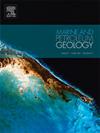贵州竹藏向斜热成因煤层气系统CO2溶解和碳同位素逆转的同位素平衡约束
IF 3.6
2区 地球科学
Q1 GEOSCIENCES, MULTIDISCIPLINARY
引用次数: 0
摘要
天然气是一种重要的能源。天然气的同位素组成对认识天然气的成因、热成熟度和次生蚀变具有重要意义。在不同的天然气系统中都观察到动力学和平衡同位素分馏。然而,控制原生天然气同位素组成的主要机制(平衡机制或动力学机制)仍不清楚。煤层中形成并储存的煤层气是研究这一关键问题的理想天然气。我们收集了中国Zhuzang向斜的CBG和产水样品。研究表明,煤层气是燕山期造山期形成的过成熟热成气。在CBG形成过程中,CH4-C2H6-CO2体系可能接近碳同位素平衡。然而,后来的变化,如大气水分补给、CO2溶解和CBG恢复,导致CH4-C2H6-CO2-DIC(溶解无机碳)体系的同位素不平衡明显。碳同位素倒转(δ13CCH4 >;δ13CC2H6),这是由于CBG形成后δ13CC2H6值减小所致。根据同位素平衡,估算了原乙烷的δ13C值。一些常用于解释天然气同位素逆转的假设不能解释CBG样品的同位素逆转。我们认为CBG开采过程导致δ13CC2H6负增加,δ13CCH4 >;δ13 cc2h6。模型估计,在热成因或微生物成因煤层气形成过程中产生的53 - 99%的二氧化碳已经溶解到煤层气水中成为DIC。因此,在地质时间尺度上,溶蚀圈闭是煤层中二氧化碳储存的重要机制。研究表明,同位素平衡分馏对了解煤层气的原生地球化学组成和次生蚀变具有重要意义。本文章由计算机程序翻译,如有差异,请以英文原文为准。
Isotopic equilibrium constraints on CO2 dissolution and carbon isotopic reversal in a thermogenic coalbed gas system associated with the Zhuzang syncline, Guizhou, China
Natural gas is a vital energy resource. The isotopic composition of natural gas plays a critical role in understanding its origin, thermal maturity, and secondary alteration. Both kinetic and equilibrium isotopic fractionations have been observed in various natural gas systems. However, the dominant mechanism (either equilibrium or kinetic) that controls the isotopic compositions of the primary natural gas is still unclear. Coalbed gas (CBG), formed and stored in situ coalbeds, is an ideal natural gas for studying this key issue. We collected CBG and coproduced water samples from the Zhuzang syncline in China. This study shows that the CBG is an over-mature thermogenic gas formed during the Yanshanian orogeny. The CH4-C2H6-CO2 system was likely near carbon isotope equilibrium during the CBG formation. However, later alterations, such as meteoric water recharge, CO2 dissolution, and CBG recovery led to obvious isotopic disequilibrium of the CH4-C2H6-CO2-DIC (dissolved inorganic carbon) system. Carbon isotope reversals (δ13CCH4 > δ13CC2H6) were observed in the CBG samples, resulting from decreasing δ13CC2H6 values after CBG formation. Based on isotopic equilibrium, the δ13C values of the primary ethane were estimated. Some hypotheses often used to explain isotope reversals in natural gas cannot explain the isotope reversals of the CBG samples. We propose that the CBG recovery process led to more negative δ13CC2H6 and thus δ13CCH4 > δ13CC2H6. Model-estimated 53–99 % CO2 generated during thermogenic or microbial CBG formation has dissolved into coalbed water to become DIC. Hence, dissolution trapping is an important mechanism for CO2 storage in coalbeds over geological timescales. This study implies that isotopic equilibrium fractionation plays a vital role in understanding the primary geochemical composition and secondary alteration of CBG.
求助全文
通过发布文献求助,成功后即可免费获取论文全文。
去求助
来源期刊

Marine and Petroleum Geology
地学-地球科学综合
CiteScore
8.80
自引率
14.30%
发文量
475
审稿时长
63 days
期刊介绍:
Marine and Petroleum Geology is the pre-eminent international forum for the exchange of multidisciplinary concepts, interpretations and techniques for all concerned with marine and petroleum geology in industry, government and academia. Rapid bimonthly publication allows early communications of papers or short communications to the geoscience community.
Marine and Petroleum Geology is essential reading for geologists, geophysicists and explorationists in industry, government and academia working in the following areas: marine geology; basin analysis and evaluation; organic geochemistry; reserve/resource estimation; seismic stratigraphy; thermal models of basic evolution; sedimentary geology; continental margins; geophysical interpretation; structural geology/tectonics; formation evaluation techniques; well logging.
 求助内容:
求助内容: 应助结果提醒方式:
应助结果提醒方式:


